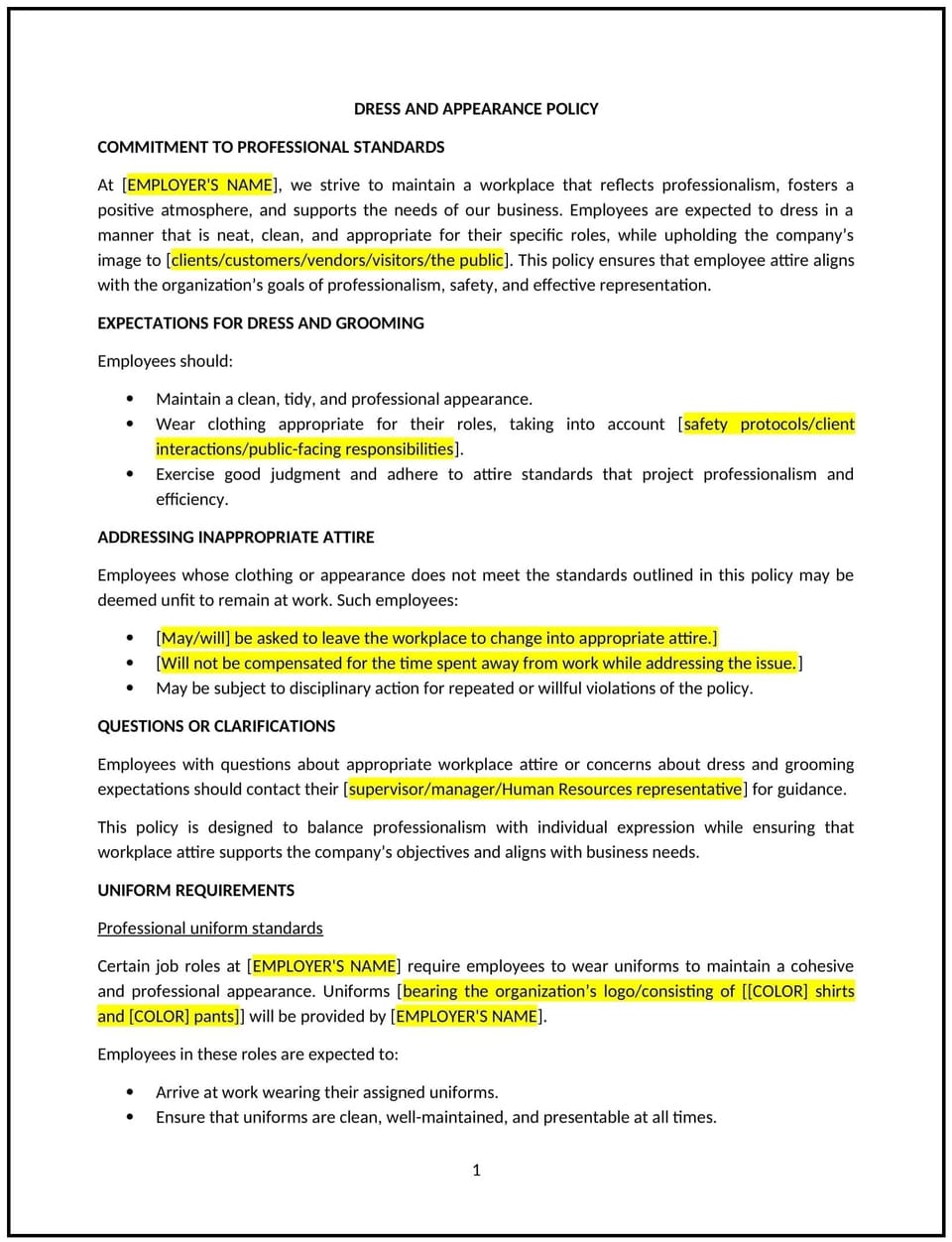Dress and appearance policy (Vermont): Free template

Dress and appearance policy (Vermont)
This dress and appearance policy is designed to help Vermont businesses establish guidelines for professional and appropriate workplace attire. It outlines expectations for employee dress and grooming standards while considering Vermont’s workplace diversity, safety requirements, and industry-specific needs.
By adopting this policy, businesses can maintain a professional image, support workplace safety, and promote inclusivity.
How to use this dress and appearance policy (Vermont)
- Define dress code standards: Specify the types of attire considered acceptable, such as business formal, business casual, or uniforms, based on workplace needs.
- Address grooming expectations: Include general guidelines for hygiene and grooming that align with professional standards.
- Incorporate safety requirements: Specify attire or equipment necessary for safety, such as non-slip shoes or protective gear, depending on the role.
- Allow accommodations: Provide flexibility for religious, cultural, or disability-related attire, in compliance with Vermont and federal anti-discrimination laws.
- Clarify prohibited attire: List items deemed inappropriate for the workplace, such as clothing with offensive language or excessive casual wear.
- Include seasonal or role-specific variations: Allow for attire adjustments based on weather, role, or industry requirements.
- Monitor compliance: Regularly review dress and appearance guidelines to ensure they align with workplace culture, safety, and Vermont regulations.
Benefits of using this dress and appearance policy (Vermont)
This policy provides several benefits for Vermont businesses:
- Maintains professionalism: Establishes a cohesive and professional image for employees and the company.
- Supports safety: Ensures employees wear appropriate attire or equipment for workplace safety.
- Promotes inclusivity: Accommodates diverse cultural, religious, and personal expressions.
- Reduces ambiguity: Provides clear guidelines for employees to understand dress code expectations.
- Aligns with legal standards: Ensures compliance with Vermont anti-discrimination laws and workplace regulations.
Tips for using this dress and appearance policy (Vermont)
- Communicate the policy: Share the policy during onboarding and include it in the employee handbook or intranet.
- Provide training: Offer guidance for managers on enforcing the policy respectfully and fairly.
- Be flexible: Allow reasonable accommodations for employees with religious, cultural, or disability-related needs.
- Encourage feedback: Invite employees to share concerns or suggestions regarding the dress code to ensure it meets workplace needs.
- Update regularly: Revise the policy to reflect changes in Vermont laws, industry standards, or seasonal considerations.
Q: What attire is considered appropriate under this policy?
A: Appropriate attire depends on the workplace setting and may include business casual, business formal, or uniforms, as outlined in the policy.
Q: Are employees allowed to wear religious or cultural attire?
A: Yes, employees are allowed to wear religious or cultural attire, and accommodations will be made in compliance with Vermont and federal laws.
Q: Can employees wear casual clothing on certain days?
A: Casual clothing may be permitted on designated days, such as “casual Fridays,” provided it aligns with professional and safety standards.
Q: What happens if an employee violates the dress code?
A: Policy violations may result in a conversation with management to address concerns and, if necessary, disciplinary action.
Q: Are there specific dress requirements for safety purposes?
A: Yes, roles requiring safety equipment or specific attire, such as non-slip shoes or protective gear, must comply with those requirements.
Q: How are dress code accommodations handled?
A: Employees can request accommodations for religious, cultural, or disability-related reasons by speaking with HR or management.
Q: How often is this policy reviewed?
A: This policy is reviewed annually or whenever significant changes occur in Vermont laws, workplace culture, or industry standards.
Q: Does this policy apply to remote employees?
A: Remote employees may follow more flexible dress guidelines but should maintain professionalism during virtual meetings or client interactions.
This article contains general legal information and does not contain legal advice. Cobrief is not a law firm or a substitute for an attorney or law firm. The law is complex and changes often. For legal advice, please ask a lawyer.


